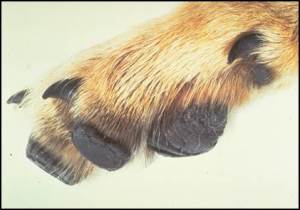
Distemper

Introduction
Canine distemper virus is a highly infectious viral disease of dogs which can cause mild signs in some individuals, but may be fatal in others. Whilst vaccination has resulted in a decrease in the incidence of this disease in recent years, pockets of infection still exist, especially in large cities where there are many unvaccinated dogs. In other countries, like Finland, the disease is still a big killer of dogs.

Aetiology
Canine distemper is caused by a large virus related to the virus causing measles in man. It is a morbillivirus virus (this group of viruses also includes measles and seal distemper). Some strains of the virus may be more pathogenic than others.

Epidemiology
Dogs less than one year of age are most commonly affected. However, those animals that have not been vaccinated or have weakened immune systems are also susceptible.
The main source of infection is by inhalation of aerosol droplets during close dog-to-dog contact. Signs can take up to three weeks to appear. The virus cannot survive easily in the environment and can be killed by most household disinfectants.

Clinical Signs
The early signs of disease are primarily respiratory with runny eyes and nose (which often becomes mucopurulent), and coughing. This is followed by depression, loss of appetite, vomiting and subsequently diarrhoea. In the later stages of the disease, dogs may develop thickening of the foot pads, known as ‘hard pad’, and nose. Dogs which survive may go on to show serious neurological signs including seizures (fits).
Photo courtesy of Dr. Hal Thomson, Canine Infectious Diseases Research Unit, University of Glasgow Veterinary School showing encrustation of eyes and nose highly suggestive of canine distemper.
Diagnosis
Diagnosis can be based on:
- Clinical signs – Runny eyes and nose, hard pad (photo courtesy of Dr. Hal Thomson, Canine Infectious Diseases Research Unit, University of Glasgow Veterinary School) and other signs are fairly distinctive for this disease though they do not provide a definitive diagnosis
- A blood test (haematology) will also show a severe decrease in the white blood cell numbers and possibly the presence of virus bodies in the cells
- Viral antigen can be detected by PCR or virus isolation – This test can identify virus in acutely infected animals from a variety of secretions and excretions. The virus is shed in faeces, ocular discharge and nasal discharge.
- Serology – An test for antibodies is available. This identifies development of immunity in recovered animals. Animals may die before antibodies develop however.
- Post mortem examination – Unfortunately many animals with distemper die. Characteristic lesions and histopathology are present in a variety of tissues and provide a definitive diagnosis.

Control
It is essential to vaccinate your dog according to your vet’s recommendations. Pups that are born to vaccinated dams usually have antibodies from their mothers (maternal antibodies) that protect them against infection during the first few weeks of their lives. The pup is in danger after the level of maternal antibodies declines and that is when it should be vaccinated.
The “7 in one” vaccine contains antigens against distemper as well as against some other serious diseases. For further information on disease and vaccination please click here.
There is no specific treatment for canine distemper, although supportive therapy in the form of intravenous fluids are often given to correct the fluid loss due to vomiting and diarrhoea. The best form of protection against this virus is through vaccination. You’ll be pleased to know that there are some vaccines that offer a duration of immunity of three years. Vaccines may only be prescribed by your veterinary practitioner from whom advice must be sought.
